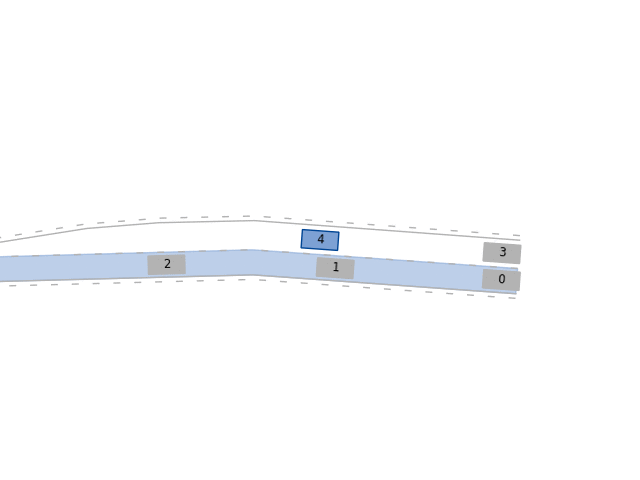BARK
Getting StartedBuilding From SourceCore ModulesDeveloping Behavior ModelsBenchmarkingAdvanced TopicsBARK-ML
Getting StartedObserversEvaluatorsEnvironmentsBARK-ML AgentsGetting Started With BARK
BARK can simply be installed using pip install bark-simulator.
To build BARK from source, have a look here.
The output of this first tutorial should be the merging scenario shown below with the ego vehicle being depicted in blue.

First, several Python and C++ BARK modules have to be imported.
The ParameterServer in BARK manages all parameters and their default values.
BARK offers several visualization options with the Matplotlib viewer (MPViewer) primed for scientific publications.
The ScenarioGeneration module specifies the initial placement, states, behavior models, goals and more of the scenario.
The Runtime is used to step the BARK simulator for a pre-defined number of steps.
All modules having a path prefix of bark.core.* are C++ modules that are wrapped for Python.
For the example, some OpenDrive, goal definitions, and behavior models have to be imported.
# BARK Python imports
from bark.runtime.commons.parameters import ParameterServer
from bark.runtime.viewer.matplotlib_viewer import MPViewer
from bark.runtime.scenario.scenario_generation.config_with_ease import \
LaneCorridorConfig, ConfigWithEase
from bark.runtime.runtime import Runtime
from bark.examples.paths import Data
# BARK c++ imports
from bark.core.world.opendrive import *
from bark.core.world.goal_definition import *
from bark.core.models.behavior import *The ParameterServer in BARK handles all default and passed parameters as shown here:
# parameters can also be set using JSON files
# param_server = ParameterServer(filename="config.json")
param_server = ParameterServer()
# this sets a default value
param_server["BehaviorIDMClassic"]["DesiredVelocity", "Default velocity", 8.]
# overwrites the default value
param_server["BehaviorIDMClassic"]["DesiredVelocity"] = 10.The scenario can be easily set up using the ConfigWithEase scenario generation which enables configuring lanes individually.
For the merging scenario, the left and right lane are configured using a LaneCorridorConfig.
class CustomLaneCorridorConfig(LaneCorridorConfig):
def __init__(self,
params=None,
**kwargs):
super(CustomLaneCorridorConfig, self).__init__(params, **kwargs)
def goal(self, world):
road_corr = world.map.GetRoadCorridor(
self._road_ids, XodrDrivingDirection.forward)
lane_corr = self._road_corridor.lane_corridors[0]
# defines goal polygon on the left lane
return GoalDefinitionPolygon(lane_corr.polygon)
# configure both lanes
left_lane = CustomLaneCorridorConfig(params=param_server,
lane_corridor_id=0,
road_ids=[0, 1],
behavior_model=BehaviorMobilRuleBased(param_server),
s_min=0.,
s_max=50.)
# this lane has controlled_ids; ego vehicle is placed on this lane
right_lane = CustomLaneCorridorConfig(params=param_server,
lane_corridor_id=1,
road_ids=[0, 1],
controlled_ids=True,
behavior_model=BehaviorMobilRuleBased(param_server),
s_min=0.,
s_max=20.)
# finally, generate 3 scenarios on the merging map
scenarios = \
ConfigWithEase(
num_scenarios=3,
map_file_name=Data.xodr_data("DR_DEU_Merging_MT_v01_shifted"),
random_seed=0,
params=param_server,
lane_corridor_configs=[left_lane, right_lane])To visualize the scenario, a viewer has to be passed to the BARK runtime.
Here, the MPViewer for scientific plots is used.
The Runtime additionally requires the scenario generator to be passed, the simulation step-time, and whether the scenarios should be rendered.
viewer = MPViewer(params=param_server,
x_range=[-35, 35],
y_range=[-35, 35],
follow_agent_id=True)
env = Runtime(step_time=0.2,
viewer=viewer,
scenario_generator=scenarios,
render=True)Now everything is set up and the BARK Runtime can be stepped.
In the code below, each of the three scenarios is stepped and visualized for 90 steps.
# run 3 scenarios
for _ in range(0, 3):
env.reset()
# step scenario 90 time-steps
for step in range(0, 90):
env.step()The video below provides a deeper understanding of and motivation for BARK: